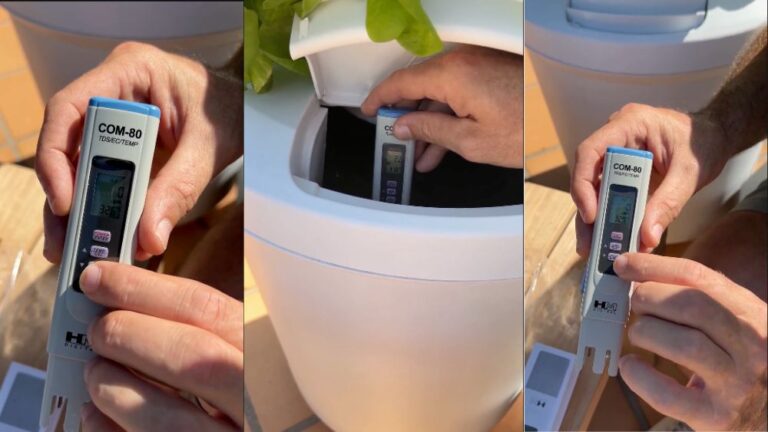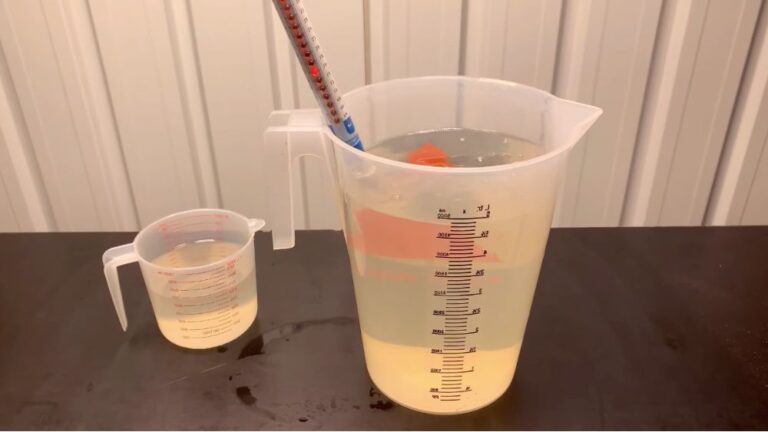
What is EC in hydroponics and why does it matter?
What is EC in hydroponics, and how does it impact plant growth? EC stands for “electrical conductivity,” an indicator of salt concentration found in nutrient solutions.
Too much salt in your hydroponic solution can prevent your plants from getting water and nutrients. Managing your nutrient concentration is essential to avoid nutrient lockouts and keep your crops healthy.
In this article, you will learn more about hydroponics and conductivity management. We’ll explain how to measure EC and adjust it to promote healthy and rapid plant growth.
What is EC in Hydroponics?
In hydroponics, EC (electric conductivity) measures the ability of mineral ions to carry electric current. An EC reading measures the concentration of dissolved mineral salts in your hydroponic nutrient solution. These salts increase the solution’s conductivity, allowing plants to absorb the nutrients they need.
The higher the EC measurement, the higher the salt concentration in the solution. Thus, it makes it harder for plants to absorb water and nutrients. Therefore, monitoring conductivity readings is critical for hydroponic growers, as it tells them the exact nutrient levels available to their plants. They can adjust the solution accordingly, using it as a guide.
How are EC, TDS, and PPM Different in Hydroponics?
EC, TDS, and PPM analyze solutions, each providing distinct information:
Total Dissolved Solids (TDS) measures the total amount of dissolved materials, both organic and inorganic, in a solution. It is typically measured and expressed in parts per million (ppm) or milligrams per liter (mg/L).
Electrical Conductivity (EC) measures a solution’s ability to conduct electricity, which is indirectly proportional to the amount of dissolved salts (ions) present.
Parts Per Million (PPM) is another unit of concentration. Similar to TDS, PPM measures the concentration of dissolved solids in a solution, expressed in parts per million.
Understanding these differences is crucial since each measurement provides insight into nutrient levels within your hydroponic system.
Role of EC in hydroponics
Hydroponics EC Levels and Nutrients
Hydroponics relies on nutrients supplied through water. Therefore, monitoring hydroponic solution strength is crucial, as it indicates the amount of dissolved nutrients available to the plants.
A balanced EC reading allows plants to grow and thrive optimally. However, not all plants meet the exact EC requirements. Some plants, such as lettuce, prefer a lower nutrient concentration, while others, such as tomatoes, require a higher EC level to thrive.
Optimizing hydroponic nutrient levels according to the type of plant can achieve the most effective results.
Hydroponic EC chart: Effect on Plant Growth and Health
Maintaining the ideal EC of the hydroponic solution is one of the critical factors for successful hydroponics. Too high nutrient concentrations can cause nutrient burn, damaging plant cells and resulting in brown or crispy edges on the leaves (leaf burn). On the other hand, too low solution strength can lead to a nutrient deficiency. It prevents plants from getting enough nutrition and makes them grow slowly or turn yellow.
In conclusion, maintaining proper EC levels ensures healthy, hydrated, and productive plants. The table below shows the optimal pH & conductivity levels for different hydroponic crops.
| Vegetable | Optimal pH Range | Optimal EC Range |
|---|---|---|
| Artichoke | 6.5-7.5 | 0.8-1.8 |
| Arugula | 6.0-7.5 | 0.8-1.2 |
| Asparagus | 6.0-6.8 | 1.4-1.8 |
| Basil | 5.5-6.5 | 1.0-1.6 |
| Bean (Common) | 6.0 | 2.0-4.0 |
| Beetroot | 6.0-6.5 | 0.8-5.0 |
| Bok Choi | 6.0-7.0 | 1.5-2.5 |
| Broccoli | 6.0-6.5 | 2.8-3.5 |
| Cabbage | 6.5-7.0 | 2.5-3.0 |
| Cucumber | 5.5-6.0 | 1.7-2.5 |
| Eggplant | 5.5-6.5 | 2.5-3.5 |
| Garlic | 6.0 | 1.4-1.8 |

Mastering Nutrient Strength: Using EC in Hydroponics
The solution strength tells growers how much nutrition plants are receiving, allowing them to make necessary adjustments.
A high EC level means evaporation concentrates nutrients, damaging your plants. Low conductivity can also result from plants using nutrients or rainwater dilution.
By understanding EC management, growers can ensure their plants receive optimal nutrients for healthy growth, minimizing fluctuations.
How to Measure EC in Hydroponics?
Methods and Tools for EC Measurements
Measuring a hydroponic solution’s conductivity is crucial for precise nutrient management. A reliable EC meter measures the electrical conductivity of your nutrient solution, empowering you to fine-tune hydroponic solution strength for healthy and thriving plants.
Using an EC meter is simple; test it by dipping it into the solution. To get accurate nutrient concentration levels, calibrate your tester regularly with solutions. Keep the meter clean and well-maintained for optimal performance.
Adjustment of hydroponic EC levels
Monitoring and adjusting hydroponic EC levels is crucial for maintaining an optimal nutrient balance for your plants. EC represents the total dissolved solids (TDS) in the water, and a proper balance is essential for healthy growth.
If the EC level indicates excess nutrients, dilute the solution with clean, pH-balanced water.
Conversely, if the conductivity is too low, it signifies a nutrient deficiency. Gradually add a pre-mixed hydroponic nutrient solution and re-check the EC after each addition.
Water quality plays a vital role in solution strength stability. Like distilled or reverse-osmosis water, a pure water source minimizes initial EC and simplifies adjustments.
How to Maintain Ideal EC for Hydroponics
Maintaining the ideal EC for hydroponics is crucial to its success. Different plants have different EC needs. Find hydroponic EC charts online for guidance.
Monitor the EC levels regularly, as they can change over time because of evaporation, plant uptake, and nutrient addition. You should adjust the nutrient concentration to match your plants’ growth stages and preferences.
You can also keep a log or journal of your conductivity readings and other observations to track changes and trends. Optimizing your hydroponic system with consistent attention to plant needs is the key to hydroponic success.
Mistakes to avoid in EC Management
Growing plants in hydroponics can be unique but also challenging. Finding the right balance of nutrients is one of your plants’ most significant challenges and solutions.
That’s where electrical conductivity, comes in. We’ll explore some of the most common mistakes farmers make when dealing with conductivity management in hydroponics and how to avoid them.
Too much trust in EC measurements
EC effectively measures the amount of dissolved nutrients in your hydroponic solution. However, conductivity is not the only factor that affects plant health and growth. In addition to solution strength, monitor your solution’s pH level. pH influences nutrient availability for your plants.
If the pH is too high or too low, your plants may not absorb the nutrients they require, even if the conductivity is perfect. Therefore, regularly monitor and adjust your hydroponic system’s EC and pH. EC is a vital aspect of hydroponics; however, it is not the only one.
Misunderstanding EC Readings
Hydroponics relies heavily on nutrient concentration levels. Some nutrients come from organic sources, like compost tea, while others come from artificial salts. However, not all organic nutrients increase EC levels. That means you could have high nutrient concentrations and a low EC reading.
It can be confusing for beginners who want to maintain optimal hydroponic nutrient levels for their plants. However, a hydroponic EC chart can help you determine the ideal conductivity range for different types of crops and stages of growth.
Regular monitoring and adjusting the conductivity level ensures your plants get enough nutrients without burning or starving them.

Final Thoughts
Electric conductivity (EC) is essential for healthy hydroponic plants. EC measures the concentration of dissolved salts in your nutrient solution. Maintaining the right conductivity balance is essential to preventing plant harm.
Hydroponic EC levels vary with plant type and stage. A hydroponic EC chart can help you find the optimum crop range and avoid nutrient deficiencies or toxicities.
Hydroponics is an excellent way to garden in urban areas with limited space. However, monitoring and managing solution strength with an EC meter and a hydroponic EC chart is crucial. It ensures your plants receive the proper nutrients for optimal growth and high-quality fruits or flowers.
FAQs
What does EC mean in hydroponics?
EC, or electrical conductivity, is critical in hydroponics because it measures the amount of dissolved ions in fertilizer solutions. It shows the strength of the nutrients, which helps growers give plants the right food for growth.
Can EC affect plant health in hydroponic setups?
EC readings directly affect plant health. High conductivity can cause nutrient burn and damage, while low EC can cause nutrient shortages, stunted growth, and leaf burn.
Hydroponics: how is EC measured?
EC meters are essential tools in hydroponics. They measure the electrical conductivity of the nutrient solution, providing growers with immediate readings. It allows them to monitor nutrient levels and adjust the solution accordingly to ensure optimal plant growth.
How do I deal with EC levels that are too high in hydroponics?
If the EC levels are too high, you can lower them by adding pure water to the nutrition mix. It keeps nutrients from burning out and ensures plants get the proper nutrients.
How can I fix my hydroponic system’s low EC level?
If the EC level is low, add mineral nutrients to the fluid in small amounts and check the conductivity level after each addition. It helps plants grow well.
Hydroponics: What is the link between EC and pH?
The pH of a solution determines its acidity or alkalinity, while the EC measures the amount of nutrients in the solution. In a hydroponic system, the pH must stay at the right level so plants can absorb nutrients.
Is it essential to keep track of hydroponic EC levels?
Growers can log EC measurements, changes, and plant responses over time in a journal. They can track data to identify trends, solve problems, and make smart choices for maintaining ideal nutrient levels in their hydroponic systems.

Meet Milan Cole, your urban gardening pro!
Milan Cole, chief content writer at Maven Gardening and an urban gardening expert, is passionate about helping city dwellers cultivate their green thumbs. Armed with extensive horticultural knowledge, Milan provides practical advice for overcoming urban gardens’ challenges, like limited space, water scarcity, and reduced sunlight.
His expertise extends beyond traditional methods, encompassing innovative approaches like hydroponic and aquaponic systems and sustainable gardening practices. Milan skillfully adapts these techniques to urban environments, considering factors like pollution and climate change.
In his clear and concise writing, Milan offers actionable solutions for anyone wanting to bring life to an urban space. He shares valuable insights into growing herbs in tight spaces, maximizing the potential of window boxes, and transforming even the most miniature balconies into thriving green oases.
Milan’s guidance is straightforward and practical, making it ideal for anyone looking to cultivate their own urban garden, regardless of prior experience.
Join Milan Cole on your journey to metropolitan Eden!
